Long Term Water Storage: How to Store Emergency Water
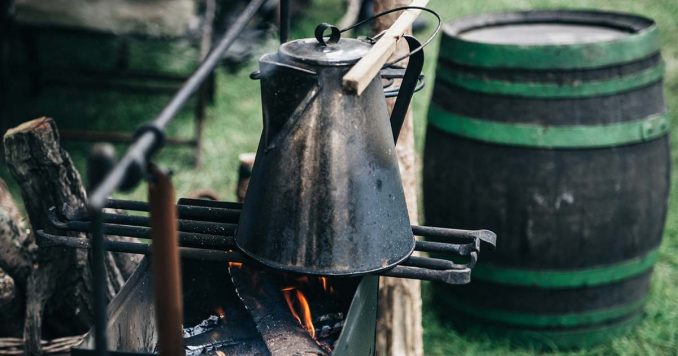
Emergency Water storage is a topic that most survivalists are pretty familiar with; unfortunately few of them actually have a long-term water plan. Considering the importance of water, it always surprises that so many survival minded people don’t take the topic more seriously.
Anyone who is prepping for a long-term survival situation needs to have a good emergency water storage solution. This solution should not only allow you to store large amounts of water but it should also allow you to capture and filter water from multiple sources.
How Much Water Should You Store?
Even in the aftermath of a short-term disaster, finding clean, drinkable water can become very difficult. Natural disasters like hurricanes, flooding, and earthquakes can cut-off or contaminate your local water supply.
How much water per person per day you should store?
At minimum, you should be storing one gallon of water per person per day, for both drinking and sanitation purposes. That means if you are preparing for a short-term disaster you should be stockpiling enough water for at least seven days.
Things that could change that number:
- If you live in a warm, dry environment, your water needs could double. For instance, if you live in the desert southwest, I would multiply the above number buy at least 1.5.
- If you have someone in your household who has a medical condition, you should think about storing extra water that goes above and beyond the recommended requirements.
- Children, nursing mothers and those who are chronically ill may need to increase their water storage requirements.
If you are planning on storing water for a long-term disaster, something that lasts for longer than 14 days, then you are going to have to develop a plan that goes far beyond stocking up on ordinary bottled water.
How long can you store water?
Theoretically, water doesn’t have an expiration date. If properly stored, water will not spoil and can safely be consumed at any point in the future. That being said, improperly stored water can be biologically or chemically contaminated so choosing the right containers and storage systems because of that much more important.
Some so-called experts will tell you that your water must be treated with bleach before storage, but if you’re using tap water from the city, it’s already treated with chlorine so adding bleach is unnecessary.
How to Store Emergency Water?
The type of storage container that you choose to work with is really up to you, and will probably be decided based on how much room you can dedicate to your water storage needs.
- When selecting areas to store your water, try to pick cool dark areas that do not receive direct sunlight.
- Make sure you stock up on multiple ways to filter and purify your water.
- Periodically check your containers and water supplies for signs of degradation.
Reusing Commercial Water Bottles
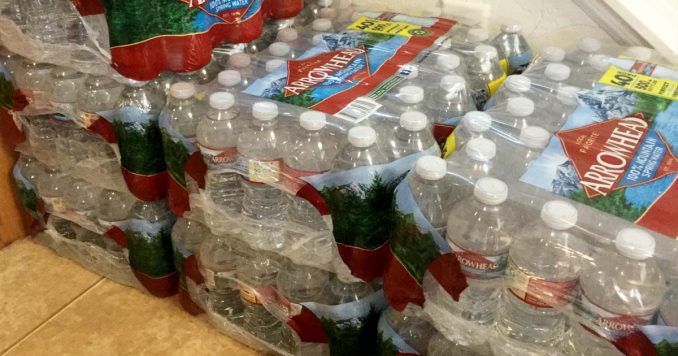
One of the cheapest and easiest ways to start storing water is to just start with some store bought bottled water. But if you’re really looking to save some money, then simply wash and refill your old plastic water bottles when you’ve finished with them. These bottles are designed to hold water, so they can be reliably used to start your preparedness stockpile.
- Most commercial water bottles can be reused at least one time; beyond that, you may have to worry about leaching from the plastic.
- I advise against using ordinary milk jugs, as they don’t last as long as other bottles and are almost impossible to completely clean.
- 2-liter soda bottles are a good, inexpensive option for water storage. They are small, easy to tuck away, and can be easily carried in a backpack when staying in one place is not an option. Just make sure to thoroughly wash and disinfect them before refilling with water.
- Think about filling any empty space in your freezers with spare water bottles. It not only gives you some extra room to work with, but it makes your freezer more efficient when filled to capacity.
Water Barrels
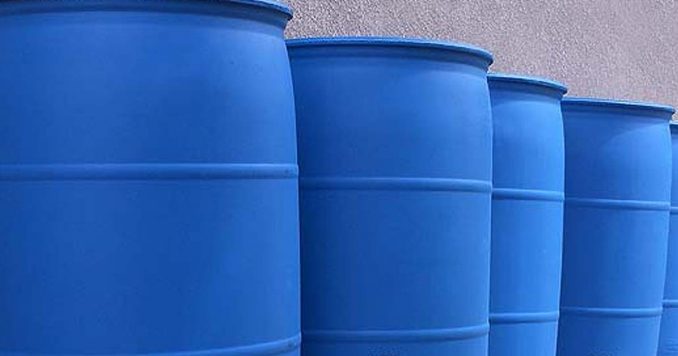
55 Gallon Water barrels are a pretty common option for survivalists, and they should be pretty easy to find at almost any outdoor sporting goods store. These barrels are usually blue, (this is done as a safety measure to ensure you know that drinking water is stored inside) and are made with heavy-duty, food-grade plastic materials.
- They are a great option if you have room in a garage or basement.
- Make sure to pretreat any water that’s stored inside these barrels. (City tap water should be fine since it’s already treated.)
Tanks, Cisterns & Rain Catchment Systems
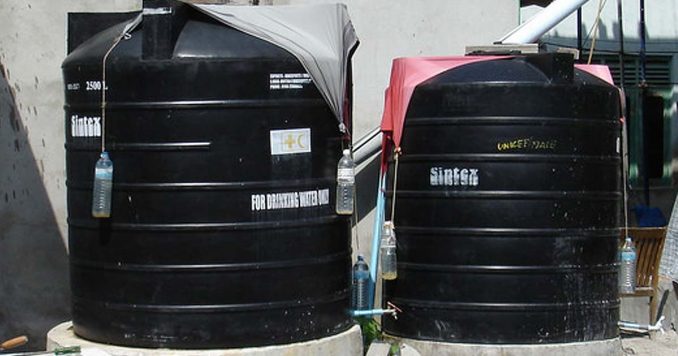
Another popular option for storing water is a freestanding tank or cistern. These tanks are popular in rural areas of the country that don’t have access to public water utilities, but can be used pretty much anywhere that rainwater runoff can be collected.
While these types of containers may be too big for some, they offer the added benefit of being able to catch rainwater by hooking them up to your rooftop gutter systems. If you can afford to install a roof catchment system, this is an excellent option for long-term survival retreats, and it can go a long way to solving a lot of your water problems.
Emergency Water Storage for Apartment Preppers
Having a large supply of water can be difficult for those living in an apartment. While some of the options above may not be feasible, there are a couple of things that you can do to prepare.
2 Liter bottles: These bottles make great containers for storing water, and are easy to tuck away in small apartments where larger storage systems are not possible. Fill up as many as you can and tuck them in your closets, under your beds, and in any other cool dark spaces that you have available.
Knowing where to find water during an emergency: Make sure you check out our article on urban water sources. It’s always a good idea to know where you can obtain water during an emergency situation.
Storing water in your Bathtub: There are two unique storage options that I think are perfect for those who live in apartments or small spaces. These are both mean as last minute items, but when disaster strikes they can help you quickly store 65 – 100 gallons of drinking water right in your own bathtub.
- The WaterBOB – We came across the WaterBob a couple of years ago and thought it was a great emergency option for people who live in apartments. Heck, it’s even good for those who just want to add a little bit of water to their supplies at the last minute. The WaterBob holds up to 100 gallons of water, is made of heavy duty food grade plastic, and will keep your water fresh and clean during a disaster.
- AquaPodKit: Similar to the WaterBOB, the Aquapodkit fits almost any tub and holds up to 65 gallons of water.
Long Term Emergency Water – Adding Filtration is the key!
Storing water is great, but should the day come when you run through your supplies you’re going to need a way to find and filter your water. The finding part is going to be up to you, but there are some things you can do ahead of time that will help.
Finding local water sources during an emergency:
- Map out as many local watering holes as you can find before a disaster hits. Jump on Google Earth and try to find any large bodies of water that are within walking, and then driving distance of your home.
- Make sure you have a way to transport the water back home. Purchase a couple of dedicated containers now, so you have them when you need them.
- Knowing where these natural sources are will be your lifeline if things go really bad. Don’t neglect this part of your plan.
Water Storage Treatment: How to filter your survival water supply
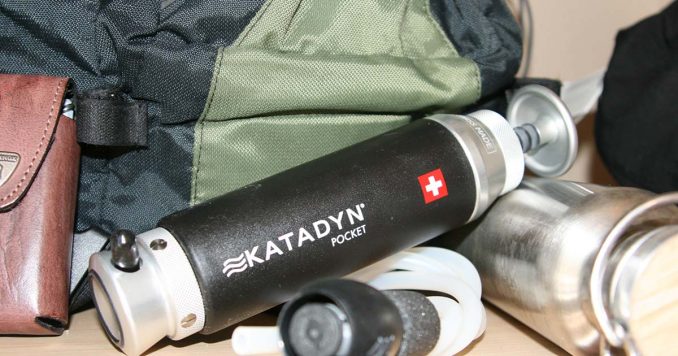
A good water filter is one of the most important pieces of gear you can have. Without water, you’re pretty much screwed. There are a number of quality water filters on the market, but there are a couple that you might want to consider first.
Berkey Water Filter – The Berkey Water Purification System is a popular filter in the survivalist community. The Berkey can remove viruses, pathogenic bacteria, cysts, and can even filter out chemicals.
Hiking Filters – One of the best portable water filters that I’ve found is the Katadyn Pocket Water Microfilter. While this is one of the more expensive hiking filters on the market, it is also the most reliable and can be used for far more than just hiking. This little filter can handle over 13,000 gallons of water and will filter all microorganisms larger than 0.2 microns. Its small size makes it a great fit for any bugout bag or survival kit.
Good Quality Pots – Another thing you should consider is having a couple good stainless steel pots for boiling water. While it will not remove chemicals, boiling water is probably the most effective way of killing viruses and pathogens.
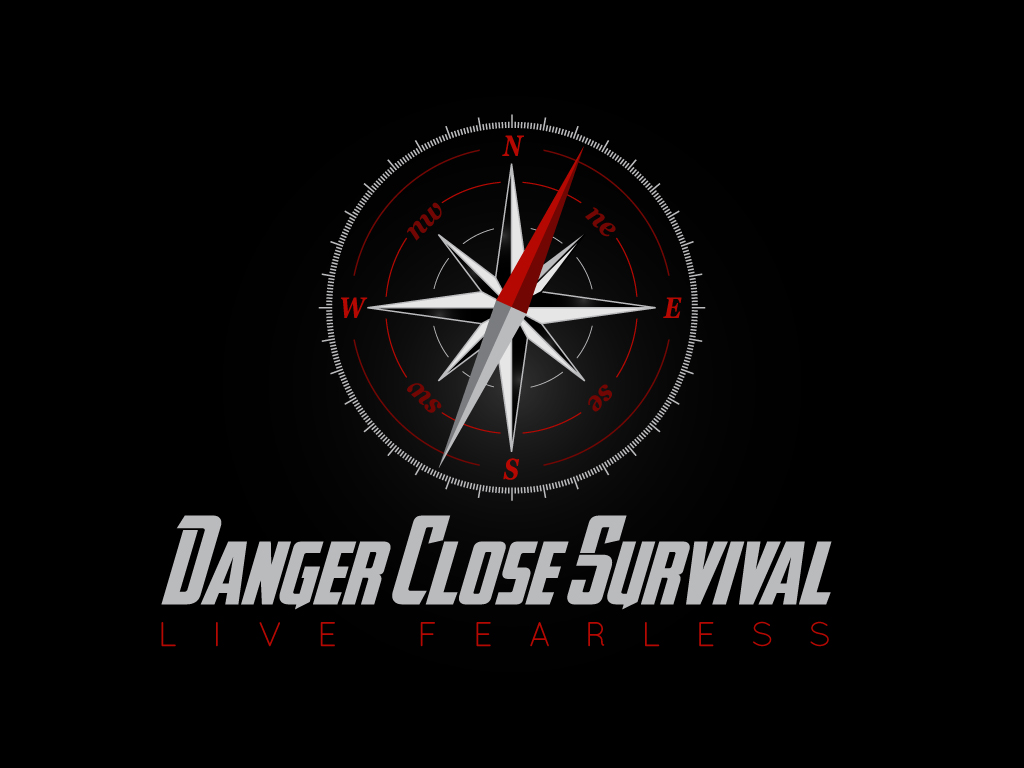
 Previous Post
Previous Post Next Post
Next Post